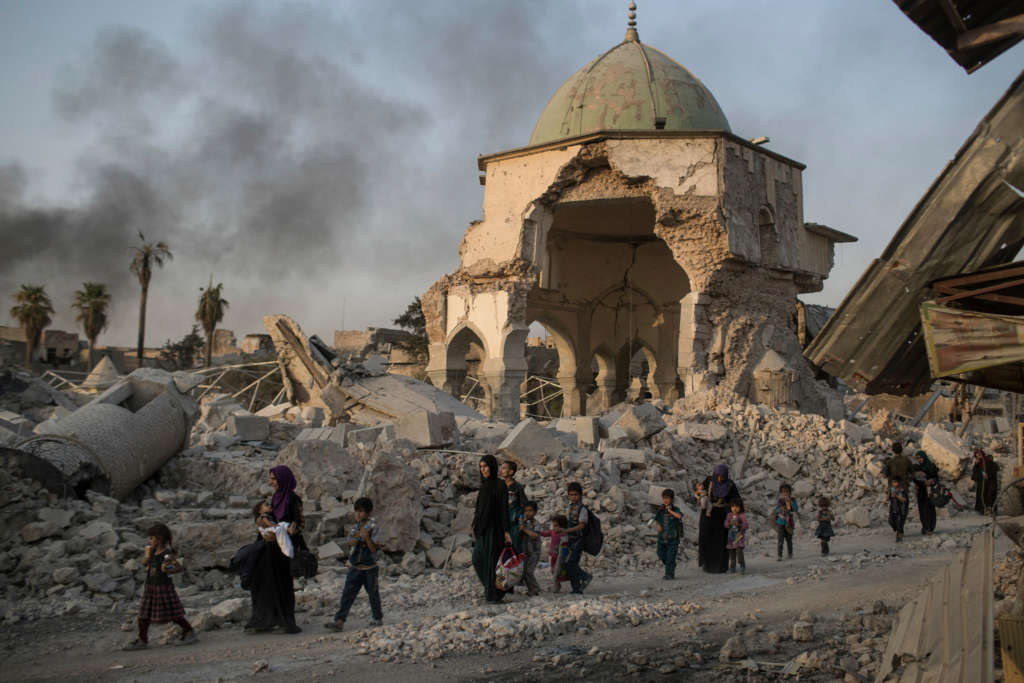Beirut — Three years ago, a black-clad cleric named Abu Bakr al-Baghdadi ascended a mosque pulpit in the Iraqi city of Mosul and addressed the world as leader of a new terrorist state.
The announcement of the so-called caliphate was a high point for the extremist fighters of ISIS. Their exhibitionist violence and apocalyptic ideology helped them seize vast stretches of territory in Syria and Iraq, attract legions of foreign fighters and create an administration with bureaucrats, courts and oil wells.
In Syria, American-backed militias have surrounded Raqqa, the group’s capital, and breached its historic walls. Across the border, Iraqi forces have seized the remains of the Mosul mosque where Baghdadi appeared and besieged the remaining jihadists in a shrinking number of city blocks.
But the loss of its two largest cities will not spell a final defeat for ISIS, according to analysts and American and Middle Eastern officials. The group has already shifted back to its roots as an insurgent force, but one that now has an international reach and an ideology that continues to motivate attackers around the world.
“These are obviously major blows to ISIS because its state-building project is over, there is no more caliphate, and that will diminish support and recruits,” said Hassan Hassan, a senior fellow at the Tahrir Institute for Middle East Policy in Washington and a co-author of a book on the group. “But ISIS today is an international organization. Its leadership and its ability to grow back are still there.”
ISIS has overshadowed its jihadist precursors like al-Qaeda by not just holding territory, but by running cities and their hinterlands for an extended period, winning the group credibility in the militant world and allowing it to build a complex organization.
So even while its physical hold slips, its surviving cadres — middle managers, weapons technicians, propagandists and other operatives — will invest that experience in the group’s future operations.
And even though its hold on crucial urban centers is being shaken, ISIS is in no way homeless yet.
In Iraq, the group still controls Tal Afar, Hawija, other towns and much of Anbar Province. In Syria, most of its top operatives have fled Raqqa in the past six months for other towns still under ISIS control in the Euphrates River valley, according to American and Western military and counterterrorism officials who have received intelligence briefings.
Many have relocated to Mayadeen, a town 110 miles southeast of Raqqa near oil facilities and with supply lines through the surrounding desert. They have taken with them the group’s most important recruiting, financing, propaganda and external operations functions, American officials said. Other leaders have been spirited out of Raqqa by a trusted network of aides to a string of towns from Deir al-Zour to Abu Kamal.
American Special Operations forces have targeted this area heavily with armed Reaper drones and attack planes, disrupting and damaging ISIS’ leadership and ability to carry out plots. But the battle for Raqqa still could last many months.
It is all a new chapter in the history of a group whose roots go back to the United States’ invasion of Iraq in 2003.
Fighting under various names and leaders, the militants who would evolve into ISIS killed many Iraqis and American troops before tribal fighters paid by the United States decimated them, driving the survivors underground by the time the United States withdrew from Iraq in 2011.
But new conflicts provided new opportunities. After the outbreak of the civil war in Syria in 2011, the group dispatched operatives there to build the force that later seized the country’s east, including Raqqa, which became its administrative capital.
Then it turned its sights back to Iraq, seizing Mosul in 2014, where Baghdadi made clear what distinguished his followers from al-Qaeda: They were not just insurgents, but also the founders of a state infused with extremist ideology.
Now, senior American intelligence and counterterrorism officials say that more than 60,000 ISIS fighters have been killed since June 2014, including much of the group’s leadership, and that the group has lost about two-thirds of its peak territory.
But those officials, including Lt. Gen. Michael K. Nagata, one of the Army’s top Special Operations officers, also acknowledged that ISIS had retained much of its ability to inspire, enable and direct terrorist attacks.
“When I consider how much damage we’ve inflicted and they’re still operational, they’re still capable of pulling off things like some of these attacks we’ve seen internationally,” General Nagata said recently in an interview published by the Combating Terrorism Center at West Point, “we have to conclude that we do not yet fully appreciate the scale or strength of this phenomenon.”
ISIS has carried out nearly 1,500 attacks in 16 cities across Iraq and Syria after they were freed from the militants’ control, showing that the group has reverted to its insurgent roots and foreshadowing long-term security threats, according to a study also published by the West Point center.
Internationally, ISIS has partly compensated for its losses at home by encouraging affiliates abroad — in Libya, Egypt, Yemen, Afghanistan, Nigeria and the Philippines — and by activating operatives elsewhere.
Between 100 and 250 ideologically driven foreigners are thought to have been smuggled into Europe from late 2014 to mid-2016, nearly all through Turkey after crossing a now rigidly enforced border, European intelligence officials say.
But they may not be the most dangerous threat facing the European authorities as long as ISIS ideology continues to motivate attackers.
A recent study by the Program on Extremism at George Washington University and the International Center for Counter-Terrorism examined 51 successful attacks in Europe and North America from June 2014, following the declaration of the caliphate, until June 2017, revealing that only 18 percent of the 65 attackers were known to have fought in Iraq or Syria.
The New York Times
